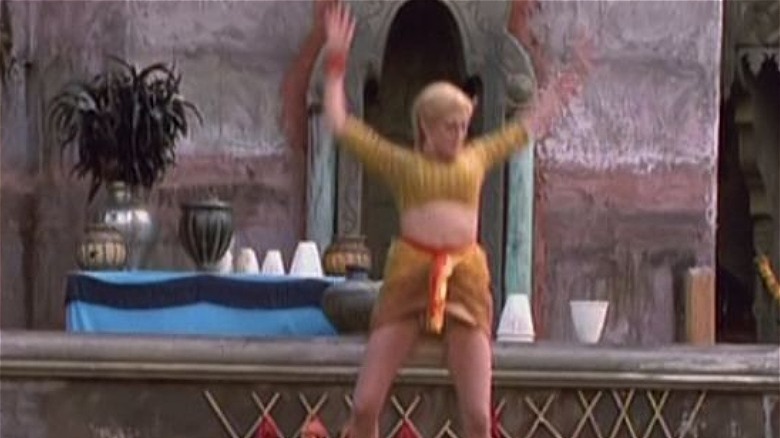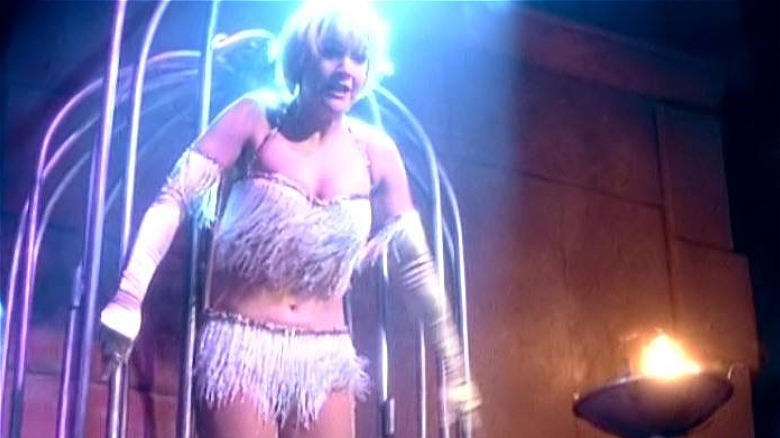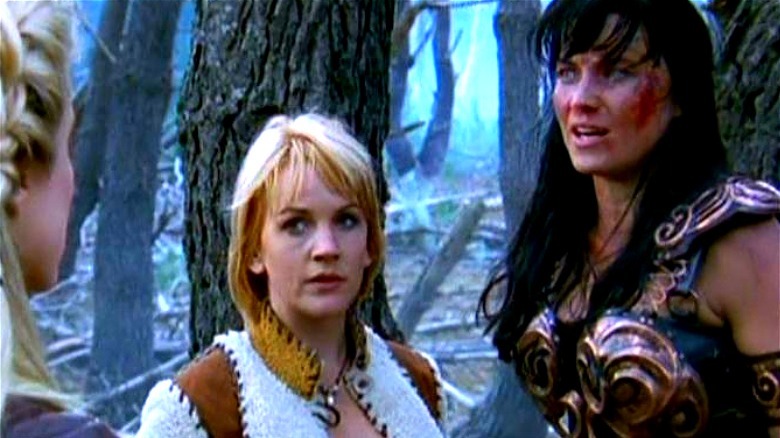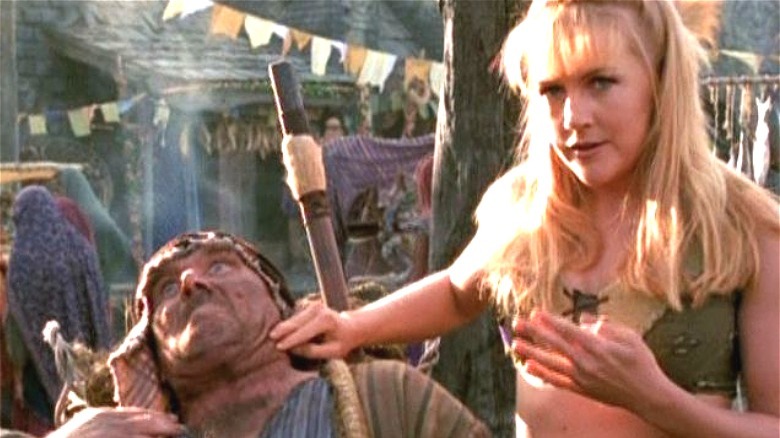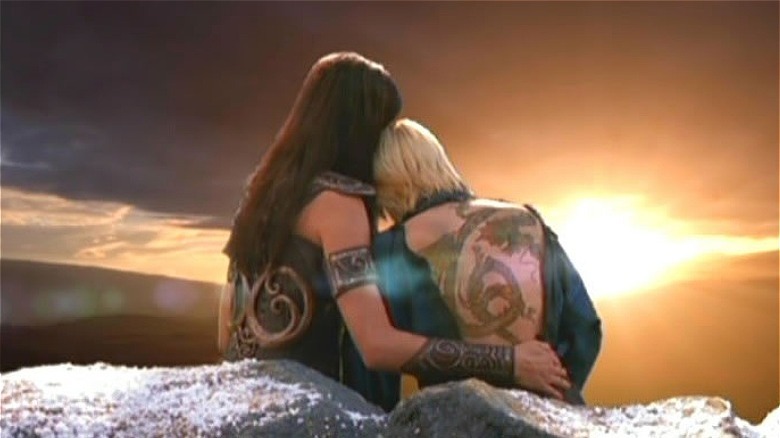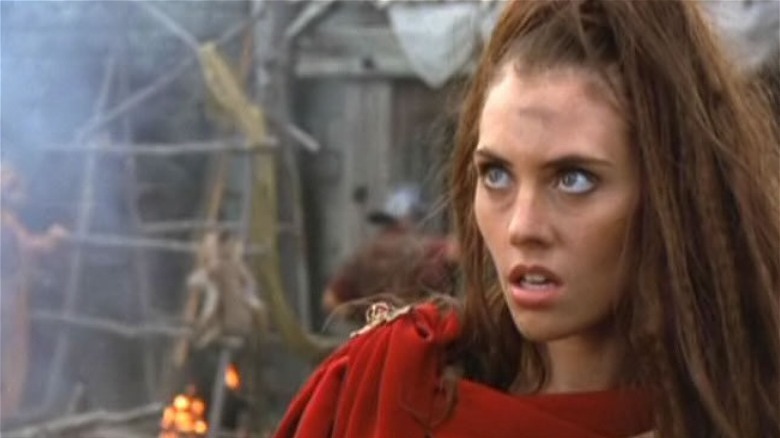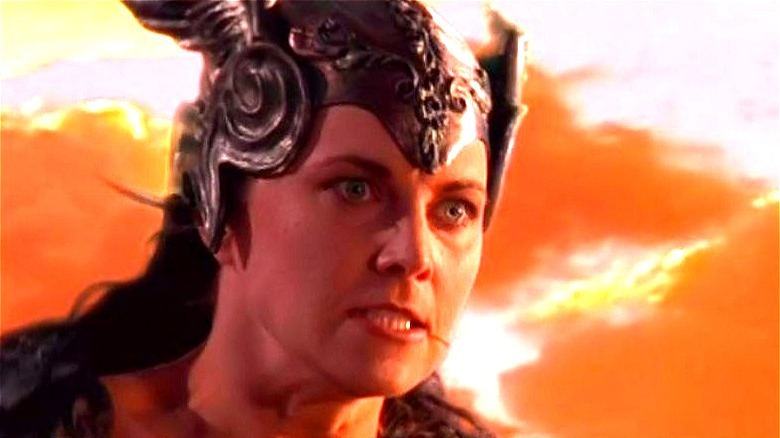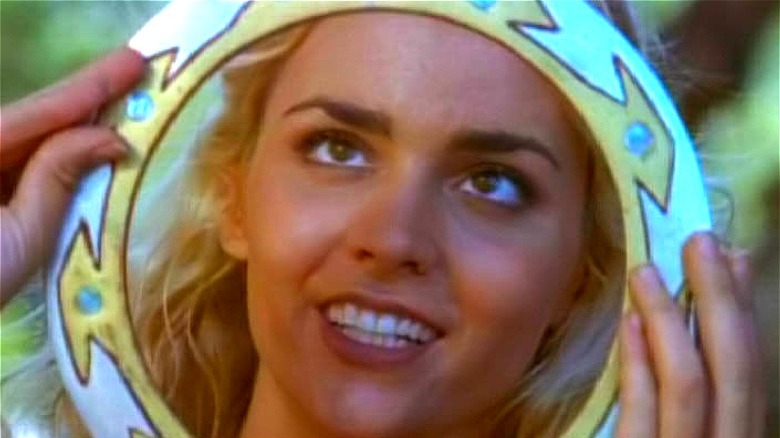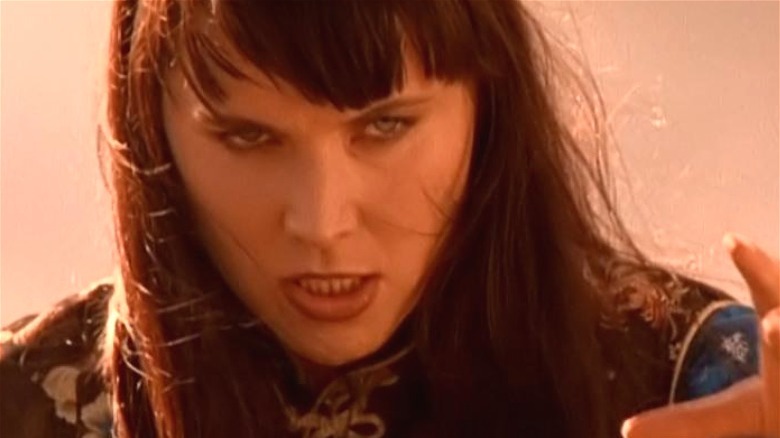Questionable Things We Ignore In Xena: Warrior Princess
Originally airing as a spin-off of "Hercules: The Legendary Journeys," "Xena: Warrior Princess" went on to become more popular than its parent series. More than just a series about two adventurers facing down gods, monsters, and warlords, "Xena" evolved into an epic tale of redemption, growth, and enduring love. Starring Lucy Lawless as Xena and Reneé O'Connor as her traveling partner Gabrielle, the series became iconic for its feminist characterizations and themes and achieved cult status among the LGBTQ+ community.
Over its six-season run, the show would offer up plenty of swashbuckling adventures and memorable characters. But it wasn't without its flaws, from iffy writing choices to production misses to things that just don't make sense. Fortunately, with a series as fun as "Xena," its more perplexing moments are easy to overlook and sometimes even add to the show's charm. Let's take a closer look at some of the questionable things we ignore in "Xena: Warrior Princess."
Stunt doubles that look nothing like the actors
With a series all about the adventures of a warrior princess, stunt doubles are an unavoidable part of life, and sometimes the show's body doubles are distractingly obvious. Mere seconds after a grieving, remorseful Xena buries her warrior attire in "Sins of the Past" (Season 1, Episode 1), head swimming with the cruelty she had brought upon others, the warrior princess finds herself taking down baddies one by one in only her slip and boots, literally kicking off a saga full of action-packed adventure and wild stunts.
Lucy Lawless (Xena) and Reneé O'Connor (Gabrielle) perform plenty of their own fight scenes and stunts over the course of the series, with O'Connor telling Australia's New Weekly Magazine in 1998 that she had been taking martial arts lessons so she could perform more action scenes on her own. But there was still plenty of work for stunt doubles on set like the incredible Zoë E. Bell, who worked as a double for Lawless from 1998 until the series ended.
Unfortunately, "Xena: Warrior Princess" stunt doubles and stunt cuts don't always blend seamlessly into the story, often standing out to the point of distraction. One of the more egregious examples can be seen in "Devi" (Season 4, Episode 14) as a possessed Gabrielle jumps on Xena's back. Every time the camera pans out, Gabrielle's hair completely changes from a tight braid to a fluffy, loose look. Another clear example takes place in the final two minutes of "A Necessary Evil" (Season 2, Episode 14) when Xena and Gabrielle are seen sitting on top of the cliff near the lava river. Reneé O'Connor's stunt double has a more angular face, and once more, her wig clearly doesn't match the color of Gabrielle's hair.
Wanton anachronisms
One of the great things about "Xena: Warrior Princess" is that the series never claims to be historically accurate, instead wantonly thumbing its nose at history while stirring mythologies together into a wickedly delicious goulash. Some anachronisms are subtle, like Xena's encounters with gods. As a Greek warrior, Xena spends plenty of time battling the Olympian pantheon from Ares, God of War, to Bacchus, God of Wine, and even has run-ins with contemporary Hindu gods like Krishna and Shakti. But she also encounters her share of Norse gods like Odin, finds a nemesis in Julius Caesar, and even pulls an Arthurian sword from a stone in "Gabrielle's Hope."
Viewers don't have to be history buffs to catch some of the more glaring anachronisms, like when Gabrielle even invents the 16th-century parlor game charades in "Forgiven." Then there's the anachronism-laden music festival of "Lyre, Lyre, Hearts on Fire," which featured Xena and company in a battle of the bands, breaking out in song to tunes like "War" and "Dancing in the Moonlight." If that wasn't over-the-top enough, the episode also features heavy metal, a fringe bikini, a rap battle, and a mosh pit.
Lady armor
Xena may have been a feminist icon, but taken as a whole, "Xena: Warrior Princess" is a case study in terrible lady armor, also known as the "chainmail bikini" or "boob armor" trope. In the series, Xena wears several variations of the iconic outfit she sports when first appearing as a villain on "Hercules: The Legendary Journeys." The original outfit was designed by Barbara Darragh, who told NZ On Screen that she drew on Roman influences for the primary design before adding Art Nouveau-inspired metal details. In almost every iteration, Xena's signature costume features a leather corset and a metal breastplate that would do little to protect anything other than the warrior princess' breasts (via Quartz).
And Xena isn't the only boob armor-rocking hero in the series — the eventually-redeemed villain Callisto (Hudson Leick) wears a studded bustier and skirt, leaving her midsection completely vulnerable. In her days as the Roman warlord Livia, Xena's daughter Eve (Adrienne Wilkinson) wore armor that consisted mainly of a metal bralette, gauntlets, and epaulets. And then there's the skimpy metal Samurai bikini Xena wore while getting pelted with arrows in "A Friend in Need Part II" (Season 6, Episode 22). No wonder it's her last melee. At least Joxer has the good sense to wear a pasta strainer before heading into battle!
Magical pressure points
Xena is a master of many things, from chakram-wielding to consecutive backflips to judgmental side-eye, so it's little wonder her pressure point skills would put the Vulcan race to shame. Plenty of fictional characters have made use of this handy trope, like when Fezzik in "The Princess Bride" uses a pressure point to subdue Princess Buttercup, and or when Mr. Miyagi heals Daniel Russo at the end of "The Karate Kid." But Xena takes magical pressure points to the next level and seems to have a pressure point for every occasion.
Her most frequently used pressure point is the Pinch, which she uses to completely immobilize the recipient, typically for interrogation purposes. To use the Pinch, Xena quickly jabs her victim's neck in two spots, cutting off blood flow to their brain. After performing this move, she has about 30 seconds to perform a second move and reverse the Pinch before her subject dies. But the Pinch is just one of many handy pressure points the warrior princess has in her arsenal: In "The Last of the Centaurs" (Season 6, Episode 17), Xena uses a pressure point as an ancient Greek epidural, and in "The Lost Mariner" (Season 2, Episode 21), she shows Gabrielle a pressure point for quelling seasickness.
Xena's superhuman abilities
Unlike many action heroes, Xena's abilities are all well-earned thanks to her mental acumen and years of hard work and dedication to many types of combat training. And yet Xena's skills often seem to go far beyond what any human should be capable of. Despite being a lowly mortal, she is able to hold her own against various creatures, demigods, and gods, even nearly managing to take out Ares (Kevin Smith) until Eli (Tim Omundson) appears in the Dagger of Helios to still her hand in "Seeds of Faith" (Season 5, Episode 9).
Xena's powerful moves regularly defy physics — from running up walls to leaping extraordinary distances — and she boasts lightning-speed reaction times, even catching arrows with her bare hands. Xena regularly takes on multiple attackers all by her lonesome, often taking out multiple targets in one move with a little assist from her handy dandy chakram. In "One Against An Army" (Season 3, Episode 13), the warrior princess even goes up against an entire Persian army while a poisoned Gabrielle looks on helplessly.
The Bitter Suite (Season 3, Episode 12)
Mystical Pregnancy is a TV and movie trope where a character becomes impregnated through mystical, supernatural means, and "Xena: Warrior Princess" subjects both Xena and Gabrielle to this fate during the series run. After Gabrielle lies to Xena about killing her evil child, Hope — she just sent her floating down a river in a basket — the demonic progeny goes on to kill Xena's son Solan. The betrayal and resulting death create a rift between the two, with Xena's anger and grief so acute it drives her to torture her friend before dragging her behind a horse.
As Gabrielle fights for her life, the pair fall into a parallel reality, a wonderland called Illusia. Inside this realm resides a whimsical deity named Aleph, who looks suspiciously like Callisto. In the surreal landscape of Illusia, singing is the preferred form of communication, which gives Gabrielle and Xena a chance to process their trauma and find each other again (it also gives "Xena" fans the show's very first musical episode). It's important that Xena and Gabrielle work through their feelings instead of brushing past them, and while the episode gives them a place to do this, they ultimately switch from hate to love in the space of a few measures. For many viewers, it seems a little too convenient that after going through all of that suffering, the pair resolve their problems so abruptly.
Xena's death
There's no way around it: Ending a beloved series in a way that leaves fans feeling satisfied can be challenging, and often, what writers consider an epic ends up getting poorly received, like the controversial endings of "Lost" and "Battlestar Galactica." And as the producers of "Star Trek: Enterprise" learned when they sacrificed beloved engineer Trip Tucker, killing off a major character in the final episode is a great way to earn fans' ire. Unsurprisingly, Xenites were just as angry when "Xena" showrunners decided to end the series by killing off the warrior princess.
Despite Xena's ability to evade death and cheat the gods time and time again over the course of the series, she unexpectedly sacrifices herself to save 40,000 souls in the series finale. After putting up a valiant but losing fight, Xena refuses to let Gabrielle bring her back from the dead, explaining that her death is necessary for the souls to pass on to a state of grace. Instead of trying to find another way, Xena simply accepts her fate, watching the sunset with Gabrielle one final time before disappearing Starbuck-style. Even Lucy Lawless came to regret the ending, telling E! News she found the decision to suddenly decapitate a beloved character "awful," explaining, "I just think we thought of her as a storytelling mechanism and that was really, really offensive to all those fans."
Xena's hypocrisy about her daughter
Considering all of the trauma and pain that Gabrielle suffers when she is forcibly impregnated by Dahak, Xena's response to her own mystical pregnancy comes across as more than a little hypocritical to many fans. When Xena learns she is pregnant from a healer in "Animal Attraction" (Season 5, Episode 4), she exclaims that she doesn't meet "certain physical requirements" and that she is a "love-free zone," so it's pretty clear that she understands the pregnancy is likely supernatural in nature.
But despite knowing how poorly Gabrielle's supernatural impregnation turned out for her, Xena immediately declares the news to be "great." While excitement about a new pregnancy is understandable, Xena's response is especially distasteful when considering her previous insistence on killing Gabrielle's child right away. Although Xena later learns that the child is the reincarnated spirit of her redeemed enemy Callisto, the child grows up to become Livia, the B**** of Rome, murdering many of Eli's followers, Joxer (Ted Raimi), and countless others in a genocidal rampage before she is eventually redeemed. It's hard to imagine that watching this play out wouldn't bring up some resentment in Gabrielle.
Season 5 as a whole
Every TV series has its high and low points, and for many fans, Season 5 is the weakest link in the "Xena: Warrior Princess" saga. Production of the series faced several challenges, including Lucy Lawless' pregnancy, thinned ranks owing to "Lord of the Rings" production, and showrunner Robert Tapert's focus on other projects like "Cleopatra 2525." As a result, the season lacked a clear overarching story arc and ended up a mishmash of comic episodes and underwhelming storylines.
Some of the worst offenders include "Little Problems" (Season 5, Episode 8), when Xena's spirit becomes trapped in a child's body, and "Married With Fishsticks" (Season 5, Episode 15), the absolutely bonkers episode where a merman version of Joxer tries to reenact the plot of 1987's "Overboard" with Gabrielle and his three terrifying fish children. To add insult to injury, the series takes a 25-year time jump toward the end of the season, leaving behind many of the show's most beloved recurring characters, like Minya (Alison Wall) and Autolycus (Bruce Campbell).
The American accents
Pulling off an accent for any role can be a tremendous challenge, but that challenge gets multiplied when just about every actor on the series has to learn a new accent. American audiences might take it for granted that the cast of "Xena: Warrior Princess" generally speaks with an American accent, but the New Zealanders who star in the series put a lot of work into theirs. Although the series was filmed in New Zealand, it was produced by Americans for an American audience, and producers felt the actors should speak with an American accent.
While Danielle Cormack, who played Amazon Queen Ephiny, would later refer to her accent on the show as "terrible" (via YouTube), overall, most of the cast did a pretty good job. If you listen carefully, some of their accents are a bit sus around the edges, but for New Zealanders playing Ancient Greeks with a California dialect, it's still not too shabby at all.
Everyone speaks the same language
Throughout the six seasons of "Xena: Warrior Princess," Gabby and Xena travel far and wide through Europe, Asia, and Africa, and everyone they encounter is able to somehow understand each other. In the world of TV fantasy shows like "Xena," some things — like characters encountering multiple languages — are just too messy to deal with, and producers make up handy shortcuts to get around them.
To avoid getting bogged down with he said, she said and constant subtitles, many fantasy and science fiction shows develop their own workaround like the universal translator in "Star Trek" or the TARDIS's telepathic field in "Doctor Who." But other shows just leave out translation altogether and gift their world's inhabitants with the lingua franca of the audience's native tongue. "Xena" takes this approach, which is why Xena and Gabby are able to easily get by in places like India, Chin, and Norseland without having to pick up a guidebook.
The magical chakram
Anyone who has ever rolled a D20 can attest to the importance of a good weapon. Like all good adventurers, Xena carries a handful of weapons for both close and ranged combat, including a double-edged sword, a whip, a boot-stashed throwing knife, and a breast dagger, as well as her signature weapon, the chakram. Originating in India, the chakram is a real weapon that can be thrown or used in close combat. For the first few seasons of "Xena: Warrior Princess," Xena wields a Dark Chakram stolen by Ares from the god Kal, but later, she fuses the Light and Dark Chakram together to create the Yin-Yang Chakram ("Chakram," Season 5, Episode 2).
The extent of the chakram's magic is up for debate amongst Xenites, but when the warrior princess wields it, the shiny danger Frisbee seems to do some pretty amazing things. Xena's chakram functions like a boomerang, always returning to her after it's thrown after ricocheting off a few people and objects, and she is able to easily catch it without injuring herself on its blade. Xena is able to take out or disarm numerous enemies with her chakram in one throw, and the weapon can even change directions in midair. Whether the chakram is imbued with special abilities or these feats are thanks to Xena's awesome skills alone, it sure is fun to watch.
The clip show episodes
Finding a way to produce a quality show within the often-limited budget is one of the great challenges faced by showrunners, and one solution for this age-old problem is the clip show. But finding ways to make a clip show that doesn't feel like a clip show is an art form all on its own, and unfortunately, it's not one the "Xena" producers were able to master.
One of the things "Xena" fans love about the series is its ability to tell a powerful story of suffering and redemption while taking plenty of whimsical detours down campier paths, which is why it's not surprising that the show took the camp approach to several clip show episodes. While they are fun, the four episodes don't add much to the series overall, apart from the fun of seeing the show's key actors in various roles. Outside of Season 2's "The Xena Scrolls" (Episode 10), which is set in 1940 and has an "Indiana Jones" feel, the other three episodes are set at the turn of the 21st century are all over the place, dealing with displaced Xebrielle clones and a reincarnated Xebby. Although there were a couple of fun spots in the fish-out-of-water clone story, it's pretty obvious that these episodes are filler, and that's hard to get past.
Xena's ability to live with her genocidal past
Once a ruthless warlord, Xena's need for redemption from the sins of her past is a constant theme throughout the series, and it's true that she doesn't try to hide from the things that she's done. What's questionable is how easily she seems to be able to get through her daily life without struggling from ongoing post-traumatic stress disorder (PTSD) from her shockingly high kill count and seems to move on pretty easily from kills even in her post-warlord days.
While it's tough to get an exact reading on how high her body count goes, it's well into the six-digit range — between the 100,000 soldiers she turns to stone in Chin in her post-warlord days and the 40,000 she accidentally killed in Higuchi village in Jappa and learned about later on. That's not to say she isn't occasionally troubled by the deaths she has caused. When visiting Cirra, the village where Callisto's parents died, Xena is overcome by images of the past. Perhaps compartmentalization is just another one of Xena's many superhuman abilities.
If you or someone you know is struggling with mental health, please contact the Crisis Text Line by texting HOME to 741741, call the National Alliance on Mental Illness helpline at 1-800-950-NAMI (6264), or visit the National Institute of Mental Health website.

